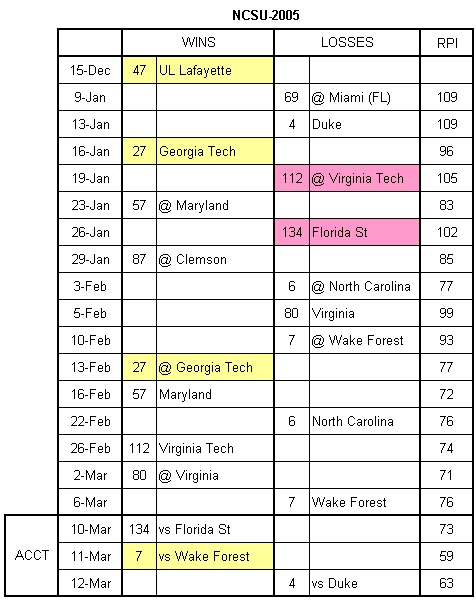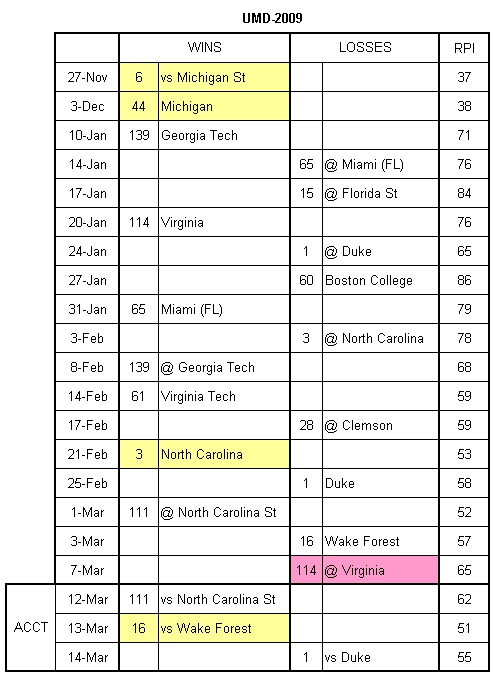.
.
.
If you find yourself in a hole, stop digging.
Will Rogers
.
.
With the current state of the US educational system, how many of the scholarship BB players in the ACC do you suppose have ever heard of Will Rogers? In any event, Will certainly identified the first step in getting out of hole. But sometimes it is important to understand how you get into a hole before you can climb out.
The teams in the bottom half of the ACC have gotten themselves there several different ways:
1) Losing too much with a very hard schedule
UNC played the #69th ranked OOC schedule, which included losses to Syracuse (#1), Kentucky (#7), and Texas (#9). Throw in the fact that three of their first four ACC games were against Top-50 opponents, then you get a bunch of losses against the #15 ranked schedule.
UNC has plenty of games left against teams currently in the upper half of the ACC….Duke x2, WF, GT, FSU, UMD. They need a few good wins along with no more losses to COC-type competition to get out of the hole. A loss to State on Tuesday would suggest that Roy isn’t listening to Will’s advice.
2) Losing too much with an easy schedule
I tend to lump NCSU and UVA together when looking at the season to date. For the most part, State’s losses look better than UVa’s (#81 USF, #120 Stanford, #141 Auburn, #228 Penn State)…but the net effect is about the same. 12-6 with an OOC SOS of 293 and 13-7 with OOC SOS of 251 lands you in pretty much the same hole.
3) Not winning enough with an easy schedule
VT (14-3) and UM (14-4) look to be doing pretty well…as long as you don’t look too closely. Both teams have OOC SOS ranked 300+, so their chances of getting into the NCAAT start to look a whole lot like the view that mid-majors have.
4) Losing to nearly anyone at any time
BC is 0-6 against teams in the Top-75 along with losses to Maine (#121) and St Joseph’s (#162). With BC’s best win coming against #87 SC, it doesn’t look too good for the Eagles this year.
Minimum NCAAT Requirements
It is simple enough to say that all of these teams need to win a lot more to get out of the hole that they have dug. But it is much more difficult to say exactly what or how many wins they need to shoot for. While I refuse to study the new format for the NIT, we have looked at the minimum requirements for the NCAAT a number of times, a number of different ways. Here are the ACC seasons and significant OOC wins for two recent ACC teams that made the NCAAT with a 7-9 conference record.
Finishing Strong
One of the interesting things to look at is the two teams’ RPI ranking at the end of Jan. #79 and #85 are not RPI rankings that we associate with receiving NCAAT bids. UMD’s Feb/March record was 4-5 with a truly embarrassing loss to UVA going into the ACCT. In 2005, State started Feb with three straight losses. The obvious conclusions are that:
1) It’s not too late to start climbing out; and
2) You don’t necessarily need to finish the regular season on an red-hot tear to still get into the NCAAT.
ACCT Wins
In 2009, UMD got into the NCAAT with a nice upset win in the ACCT. State did the same in 2005. In 2002, State had only one win against an NCAAT team…UMD (regular season champ) in the ACCT. In 2003, State had two wins against NCAAT teams; #12 Duke in Raleigh and WF (regular season champ) in the ACCT.
Contrasting these four teams with a number of 8-8/9-7 ACC teams that didn’t get an NCAAT bid leads me to the obvious conclusion that conference tournament wins are worth a lot more than regular season wins. You can argue about whether or not you think that this is “fairâ€. But it is hard to argue against the importance of ACCT wins for bubble teams.
This conclusion brings up a question about a team with a 6-10 conference record. If one upset is enough for 7-9, would a ACCT championship appearance be enough for a 6-10 team to get a NCAAT bid?
The short answer is….I don’t know for sure. In 1998, FSU finished the regular season at 6-10 and lost to NCSU in the opening round of the ACCT. FSU received an NCAAT bid that year. Does anyone think that they would get one today? (I sure don’t.) So until we get a more recent example, I guess that we file this question in the “So you’re telling me there’s a chance†category.
Extenuating Circumstances
There’s one other issue that I would to mention about the 2005 NCSU team. There were a lot of “headlines†swirling that year…Tony Bethel’s sickness and recovery, Chris Paul’s low blow and the aftermath, State’s 6-3 finish in Feb/March. Since The Dance Card “predicted†that State wouldn’t make the NCAAT in 2005, I’ve always wondered if State got some type of “sentimental†vote that you couldn’t count on every year.
Well I have some good news/bad news on this question. The Dance Card redid their algorithm last year and apparently redid the seasons up on their website. The 2005 State team is now predicted to just barely clear the bubble and land in the NCAAT. The bad news is that they no longer list the factors included in their algorithm. (So I don’t know if they changed the function/coefficients within their formula, or if they changed the six factors that I have quoted here so frequently.)
The important thing for this entry is that there is no longer any reason to put some type of asterisk beside the 2005 State team. State’s NCAAT bid in 2005 is consistent with decisions made by other selection committees. I don’t know how you feel about the selection committee and their process, but I absolutely do not want the selection committee to have the “freedom†to come up with their own criteria. I want consistency, with as little politics as humanly possible, each and every year in the selection process.
Final Thoughts
Last year, analyzing the NCAAT bubble teams in the ACC was really very boring. I suspect that this year will be much more interesting and may give us some new insights into where the line between the NCAAT and the NIT is drawn. If all goes well with me at home/work, we’ll take another look at the ACC bubble teams right before the ACCT. By then, I suspect that some of the teams in the top half of the ACC will have worked themselves into a much weaker position on the bubble.
1/26 EDIT
PS – Through games played on Sunday 1/24, the Dance Card has six ACC teams clearing the bubble…Duke, WF, GT, Clemson, FSU, and UMD.





You must be logged in to post a comment.